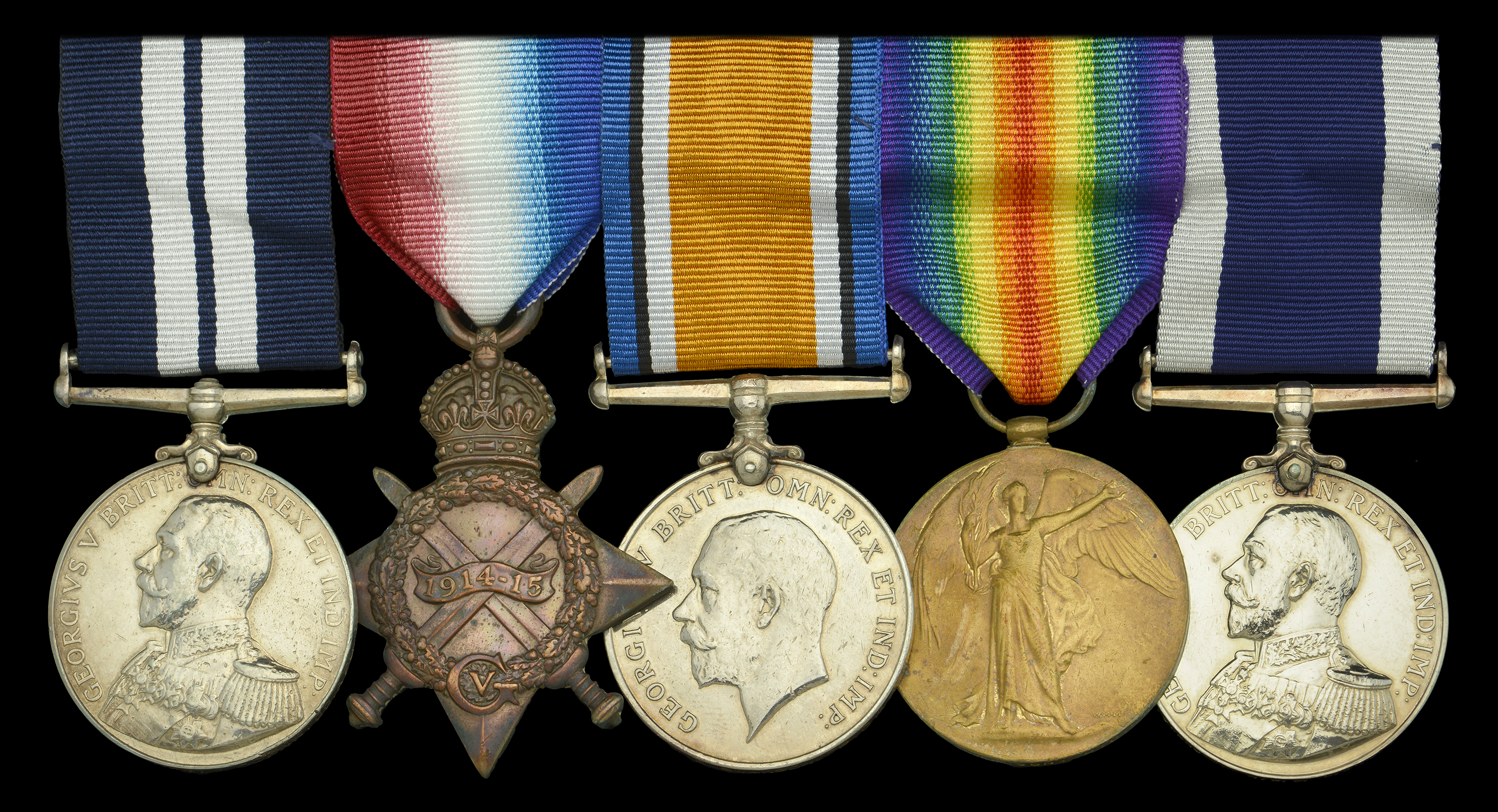The fine Great War Q-ship action D.S.M. group of five awarded to Chief Petty Officer W. E. Swanson, Royal Navy, who was decorated for his gallant gunnery work in the three-masted barquentine Gaelic (Q-22) with an enemy submarine off Ireland in April 1917 Distinguished Service Medal, G.V.R. (J.1599 W. E. Swanson, P.O. Atlantic Ocean. 22. Apl. 1917.); 1914-15 Star (J.1599 W. E. Swanson. L.S. R.N.); British War and Victory Medals (J.1599 W. E. Swanson. P.O. R.N.); Naval L.S. & G.C., G.V.R., 2nd issue with fixed suspension (J.1599 W. E. Swanson, C.P.O. H.M.S. Queen Elizabeth) edge bruising and contact marks, otherwise very fine or better (5) £1,800-£2,200 --- Importation Duty This lot is subject to importation duty of 5% on the hammer price unless exported outside the UK --- --- Provenance: Dix Noonan Webb, December 2000. D.S.M. London Gazette 20 July 1917: ‘For services in action with enemy submarines.’ The original recommendation states: H.M.S. Gaelic (Q. 22) Action with an enemy submarine on 22 April 1917. In charge of after guns during the engagement. Second shot from the port gun hit submarine in vicinity of conning tower. Fourth shot was also a direct hit a little further forward. Later when in charge of starboard after gun secured another direct hit striking the submarine just abaft the conning tower. In total 52 rounds fired from the two after guns.’ William Edwin Swanson was born in Ardglass, Co. Down on 5 March 1892, and joined the Royal Navy as a Boy 2nd Class in June 1908. By the outbreak of hostilities, he was serving as a Leading Seaman in the battleship Colossus, in which he remained employed until removing to the Vengeance in December 1915. Advanced to Petty Officer in April 1916, he subsequently witnessed active service off East Africa, including the operations that led to the capture of Dar es Salaam in the same year. Having then volunteered for decoy ships on coming ashore from the Vengeance in early 1917, Swanson served in the Gaelic (a.k.a. Q. 22) from May-October 1917. A three-masted barquentine, built in 1876, she was surely one of the oldest ships to have been employed in decoy operations. On the evening of 22 April 1917, Gaelic sighted a submarine 5000 yards away, some 50 miles south of the Old Head of Kinsale. Hands were called down from aloft immediately and action stations sounded. The submarine kept its distance and fired shell after shell, of which six hit the Gaelic, killing two of the deck hands and wounding four, besides putting the port motor out of action and seriously damaging the rigging. After a while the sailing ship unmasked her guns and opened fire, prompting the submarine to alter course and fire a torpedo. Luckily Gaelic was able to manoeuvre sufficiently for this to pass harmlessly along the starboard side. After three misses, Gaelic’s forward gun obtained a hit on the submarine but then the firing pin broke and the gun was temporarily put out of action. Firing continued from her starboard gun and the two adversaries traded shells for about 40 minutes when the submarine moved slowly away to the south-west, still firing. Gaelic had sustained a hit in her fresh-water tank which leaked through the deck onto the starboard motor, putting it out of action, rendering her completely without power on a windless evening. However, Swanson and his fellow gunners maintained their fire, and another two hits were scored on the German submarine which eventually ceased fire, but not before Gaelic scored a final hit at a range of 4000 yards. Thus ended the protracted action, each side having fired about 100 rounds and, although the submarine, the UC-47, was not sunk, she was certainly badly knocked about. Gaelic set her sails despite the badly damaged rigging and made for the Old Head of Kinsale. At daybreak, when still 10 miles short of that landfall, she was picked up by H.M. sloop Bluebell and towed into Queenstown. Gaelic’s skipper, Lieutenant G. Irvine, R.N.R., was awarded the D.S.O. for this exploit, whilst Swanson’s impressive gunnery skills earned him the D.S.M. He subsequently saw out the war with appointments in Vivid I (October 1917-July 1918) and at the Granton naval base Gunner (July-December 1918), appointments that may have included further Q-ship operations. Then in January 1919 he joined the mine-sweeper Holderness, in which ship he served in the Baltic and was mentioned in despatches (London Gazette 22 January 1920, refers). He also added the L.S. & G.C. Medal to his accolades in March 1925. Sadly, however, as verified by his service record, he started to suffer from a form of dementia and, in October 1926, he was invalided ashore and placed in the care of the Plymouth Poor Law Institution. Sold with copied research.





